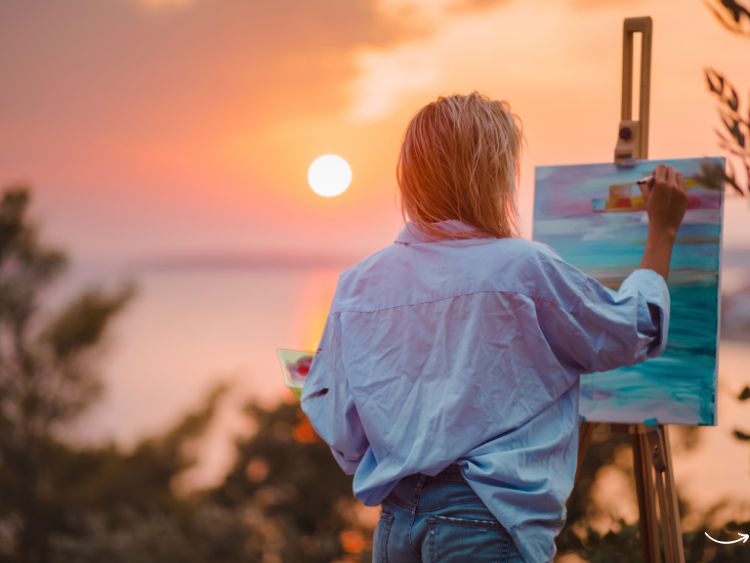Who hasn’t been mesmerized by a stunning sunset? Those vibrant hues blending seamlessly into each other, painting the sky with their magic. Now, imagine capturing that very essence on canvas – that’s the beauty of sunset painting. It’s not just an art form; it’s a celebration of nature’s daily masterpiece. Whether you’re an amateur artist or a seasoned painter, diving into the world of sunset painting offers a unique blend of challenge and serenity. So, why not embark on this colorful journey with me?
Why Paint Sunsets?
Emotional Connection
Painting sunsets isn’t merely about putting colors on a canvas; it’s about capturing a fleeting moment of tranquility and beauty. Sunsets evoke strong emotions – peace, awe, and sometimes nostalgia. When you paint a sunset, you’re not just creating art; you’re immortalizing a moment that speaks to the heart.
Practice and Skill Development
Sunset painting is an excellent exercise for developing artistic skills. The gradual blending of colors, the play of light and shadow, and the need to convey depth and perspective all provide a rich learning experience. By regularly painting sunsets, artists can significantly improve their technical skills and understanding of color theory.
Essential Tools and Materials
Paints
For sunset paintings, the choice of paint is crucial. Oil paints are a favorite among many artists because of their rich texture and vibrant colors. However, acrylics and watercolors can also be used effectively. Each type of paint offers a different experience and finish.
Brushes
Different brush types serve various purposes in sunset painting. Flat brushes are excellent for broad strokes, while round brushes are ideal for finer details. A fan brush can be particularly useful for blending colors to create that seamless gradient effect of a sunset sky.
Canvas
The size and type of canvas can impact the final result. A larger canvas allows for more detail and expression, while a smaller one can be perfect for quick studies or experiments with different color palettes.
Techniques for Sunset Painting
Color Blending
One of the most critical techniques in sunset painting is blending colors smoothly. Begin with the lightest color at the horizon and gradually blend into darker shades as you move upward. Use a soft, dry brush to blend the colors seamlessly.
Layering
Building up layers can add depth and richness to your sunset painting. Start with a base layer of the broadest, most dominant colors. Once dry, add layers of details, such as clouds or reflections, to bring the scene to life.
Light and Shadow
Understanding the play of light and shadow is essential. In a sunset scene, the light source is low, casting long shadows and creating dramatic contrasts. Pay attention to how the light interacts with clouds, water, and other elements in your composition.
Step-by-Step Guide to Painting a Sunset
- Prepare Your Workspace:
- Ensure you have all your materials ready.
- Set up your canvas and paints in an area with good lighting.
- Sketch the Basic Outline:
- Lightly sketch the horizon line and any key elements, like mountains or trees.
- Apply the Base Colors:
- Start with the lightest color near the horizon.
- Gradually add darker colors as you move upwards.
- Blend the Colors:
- Use a dry brush or a sponge to blend the colors seamlessly.
- Add Details:
- Once the base layer is dry, add details like clouds or reflections on water.
- Final Touches:
- Adjust the contrasts and add any final highlights or shadows to enhance depth.
Common Mistakes and How to Avoid Them
Over-Blending
While blending is crucial, over-blending can muddy your colors and reduce the vibrancy. Keep a balance to maintain the distinct hues of your sunset.
Ignoring Perspective
Remember to incorporate elements that convey depth and perspective. This could be a silhouette of distant mountains or the reflection of the sunset on a water body.
Lack of Patience
Rushing through the process can lead to a less polished result. Take your time to let layers dry and step back occasionally to assess your progress.
FAQs
What are the best colors to use for a sunset painting?
The best colors often include a range of yellows, oranges, reds, pinks, purples, and blues. Experimenting with these can help you find the perfect palette for your sunset.
Can beginners paint sunsets?
Absolutely! Sunset painting is an excellent way for beginners to practice blending and color theory. Start simple and gradually add more elements as you gain confidence.
How do I make my sunset painting more realistic?
Pay close attention to the light source and how it affects the colors and shadows. Adding small details like clouds and reflections can also enhance realism.
What type of canvas is best for sunset painting?
A stretched canvas is a popular choice due to its durability and texture. However, canvas boards and paper can also be used, especially for practice pieces.
How long does it take to paint a sunset?
The time can vary depending on the complexity and the medium used. A basic sunset painting can take a few hours, while more detailed works may take several days.
Summary
Sunset painting is a captivating endeavor that blends technique with emotion, allowing artists to immortalize nature’s daily spectacle. By understanding the essential tools, mastering key techniques, and avoiding common mistakes, you can create stunning sunset paintings that evoke the serenity and beauty of twilight. So, grab your brushes and paints, and let the colors of the sunset inspire your next masterpiece!







